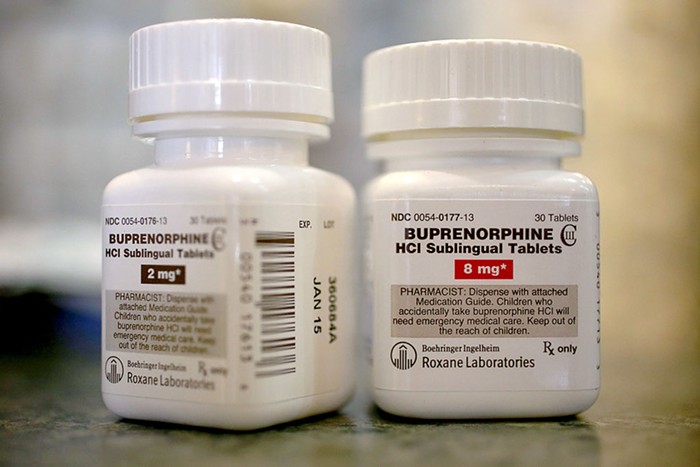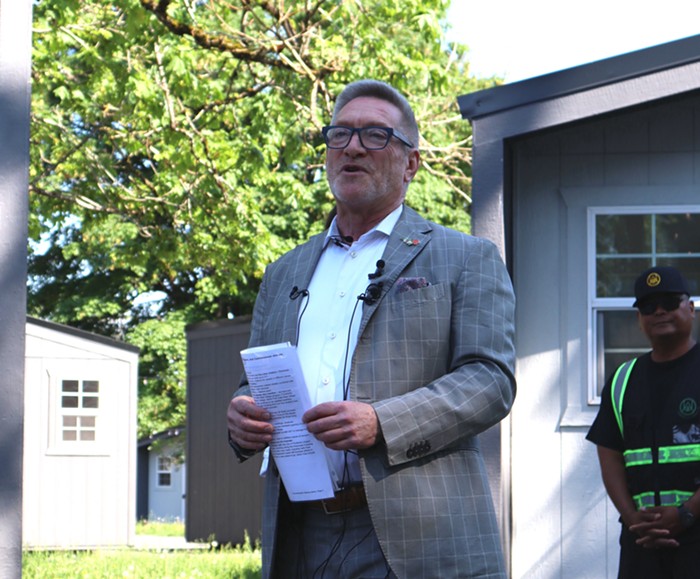A tidal wave of meth is crashing over Oregon. It's so addictive that one hit is all it takes to turn normal people into junkies—transforming them into thieving, scab-picking, toothless zombies, whose lives are controlled only by their need for another fix. It's coming after your children—your tiny, precious, pretty, white suburban children—and it won't stop until every single one of them is turning $5 tricks in seedy hotel rooms to fund their addiction.
No drug has ever been more dangerous, more addictive, more catastrophically destructive to otherwise safe communities. And none of this will stop unless we enact sweeping, harsh, and intrusive law enforcement measures, pouring even more state and federal money into the war on drugs.
This is what local governments and the media want you to believe. And they're completely full of shit.
Run for the Hills!
The hysteria over methamphetamine use has been in effect for years. However, it reached shrieking volume in 2005, otherwise known as The Year that Meth Made. In an August cover story, Newsweek declared meth to be "America's Most Dangerous Drug." The Oregonian's Steve Suo is dusting off his shelf to make way for the Pulitzer he's bound to win for an alarmist series on the drug, and the PBS Frontline series is still beaming over its haunting exposé "The Meth Epidemic," which was made in conjunction with the Oregonian. The state legislature passed a law last year that moved all cold products containing pseudoephedrine (the key ingredient for meth) behind pharmacy counters.
And don't forget, Oregon Governor Ted Kulongoski has named March "Meth Awareness Month." The timing, then, couldn't have been more perfect for President Bush's March 9 authorization of a new component of the Patriot Act, which aims to combat meth by requiring anyone purchasing pseudoephedrine cold products to show an ID and have their purchase logged in a database, restricting the amount of cold pills a person can buy, sending $99 million for law enforcement to "Meth Hot Spots," increasing penalties for use and production, and lowering the standards by which a person can be labeled a "Drug Kingpin"—a designation that can now carry a life term in prison.
For the state and federal government to spend such an enormous amount of money and resources, the problem must be earth-shatteringly massive and unprecedented, right?
Ha, ha. Nope. It only has to be sold that way. As it turns out, meth isn't even close to an epidemic. In fact, by nearly every measure, meth use is either declining or stabilizing. And we have only to look to the federal government's own numbers to prove it.
Last September, the federal Office of Applied Studies released its National Survey on Drug Use and Health (NSDUH) report, including a look at how meth use has changed from 2002 to 2004. Put simply, it hasn't changed. Or, in the report's words, "methamphetamine use... remained stable between 2002 and 2004"—hardly proof of the epidemic theory so frantically flogged by the stokers of moral panic.
The report arrives at this conclusion in a few ways. First, by looking at first-time users. In 2004, around 318,000 people reported using meth for the first time—the average first-time usage rate between 2002 and 2004 hovered consistently around 300,000. Second, the report considers the number of people who admitted to using meth in the past month (a very, very rough method of determining "habitual use"). These numbers actually dropped: From 597,000 in 2002, it edged up to 607,000 in 2003, but then slipped to 583,000 in 2004. The only number that rose in 2004 was the average age of first-time users—22 in 2004, up from 19 in 2002.
In summary: According to the federal government, first-time meth use is in decline nationwide, and the average first-time user is now four years older than the typical high school senior.
Unfortunately, the NSDUH didn't start looking at meth on a separate state-by-state basis until recently, so there aren't comparable stats specific to Oregon.
But according to the federal Substance Abuse and Mental Health Services Administration, the percentage of people treated in Oregon for "amphetamines" remained relatively stable from 2000 to 2004. In 2000, there were 7,665 people treated, equaling 14.5 percent of total admissions for all substances (alcohol, cocaine, etc.). That number peaked in 2002, with 9,463 people treated (16.9 percent of the total) for amphetamines. In 2004, the figure dropped to 8,561, but because of a lower number of treatment admissions as a whole, that equaled 19 percent.
Are the treatment numbers going up? Kind of, although they fluctuate. Is this indicative of an epidemic? Hardly.
Secure Your Valuables!
Here's a truly staggering number: 85 percent of the state's property and identity-theft crimes are fueled by methamphetamines. Eighty-five percent! The source for this news? Fox 12's screeching "Meth Watch" coverage. (Surprisingly, the news station doesn't provide any information on how they got that number.)
Let's do the math on that. If meth is responsible for 85 percent of Oregon's property crimes, that would mean the rates of theft and similar crimes would have to be nearly double what they were in pre-epidemic years—like in the early to mid-'90s. But according to the Oregon Criminal Justice Commission, that simply isn't true. In fact, property crimes (and even more so, violent crimes) have plummeted in the past decade and a half. In 1990, property crime rates were at around 521 per 10,000 people. In 2000, that figure was down to around 455 per 10,000. It has ticked back up a little since then, but in 2003 (the latest year available), the numbers were still well under the 1990 rate, and drastically lower than property crime rates in the 1980s.
Addicted to Addiction
There's one area in which the media's meth madness appears most ludicrous. That is the claim that the drug is so dangerous—so especially, uniquely dangerous—because it is so much more addictive than any other drug. A recent Fox 12 piece titled "Mom Breaks Stereotype of Meth Addicts" tells the story of a suburban mom whose "life started to fall apart after a night out at a club with friends." She was too tired to drive home, so "a friend gave her a drug that would change her life."
"If I only would have known that one line would lead to another line, to another line, and soon my addiction spiraled out of control," she explained.
One of the stories told in the Oregonian's meth series is about another mom, Debbie, who "recalled seeking solace in local bars. Friends showed her how to tighten her shirtsleeve, jab a needle into a vein and plunge in a hit of meth. Debbie felt a rush of euphoria. Her insecurities slipped away. She felt like superwoman. She was hooked."
One fix, the stories seem to imply, is all it takes to turn normal people into hopeless addicts. But here, again, the federal government's own numbers expose this to be an utter fabrication.
The NSDUH survey reports that, as of 2004, 12 million people in America (nearly five percent of people over 12) have tried meth at least once in their lives. But of those, only 1.4 million people said they'd used it in the last year. And of those, only 600,000 had used meth in the past month.
The numbers for Oregon tell the same story. In 2004, 297,000 people said they had used meth at least once in their life, but only 31,000 had used in the past year, and only 15,000 used in the past month.
In other words, the vast, vast majority of people who've ever tried meth have not become (or are not currently) habitual users or addicts. Compare this with abuse of prescription drugs reported in the same NSDUH survey. In Oregon, 731,000 people reported having used psychotherapeutic drugs for non-medical reasons, 228,000 in the last year, and 95,000 in the past month.
For those who do become addicted to meth, recovery is as effective as for any other drug. But, hysterical, the-sky-is-falling media reports could ultimately make it more difficult for addicts to recover. Karen Wheeler and Jay Wurscher, substance abuse officials at Oregon's Department of Human Services, recently put out a news release arguing that the onslaught of media stories about "meth mouth," "meth babies," "meth houses," and meth-linked crime is fueling the false perception that meth addicts can't recover. That stigma makes it harder for those in recovery to return to a normal life, and if they are unable to get a job or a place to live, their odds of a relapse skyrocket.
Wheeler and Wurscher also had this to say—"Most news stories link meth use to criminality: people who abuse or neglect their children, who cook and sell meth, or who commit other crimes. But most meth addicts are not criminals. This may surprise you, but most addicts are working."
Addiction specialists shouldn't get their hopes up. If anything, meth hysteria will only increase, despite the fact that use is decreasing. Highly emotional, anecdotal stories—which ignore the facts—help move newspapers, sell advertising for nightly "Meth Watch!" news segments, and convince the federal government to hand over money to cash-strapped local law enforcement agencies.
But they also foster irrational fears among the general population and, at their worst, force elected leaders to draft new costly, overreaching laws, and make it more difficult for recovering addicts to re-enter society.
In other words, media hysteria is making the problem much, much worse.


















